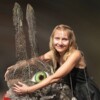 Irena Aizen, Brenna-5 (2024)
Irena Aizen, Brenna-5 (2024)
Irena Aizen, born in Russia and residing in Israel since 1990, is a Russian-Israeli artist from a family of creators. Graduated from the Art College of Yaroslavl (Russia) in 1981, she began her career as an illustrator in a Russian publishing house before fully dedicating herself to her art after moving to Israel.
Her work blends surrealism and symbolism inspired by Northern Renaissance. Through animal representations, notably hares, she delicately and poetically explores the psychology of human relationships. Her artistic universe, infused with mystery and sensitivity, captivates a wide audience. Her works are exhibited in galleries in Israel, the United States, and Europe, and are part of prestigious private collections. Her distinctive style, characterized by rich colors and intricate details, evokes a visual narrative that transports the viewer to a dreamlike and timeless world.
Since January 2025, her work has experienced immense success on TikTok, where her creations go viral and are widely shared. Some videos reach several million views, generating global enthusiasm. Her hares, blending classical influences and modern techniques, have become a true signature. Internet users are fascinated by their unique aesthetics and emotional charge, amplifying her notoriety on social networks. This digital success has also led to an increase in demand for her works, making her a sought-after artist among contemporary art collectors.
Aizen does not settle for ephemeral success on social media; she uses this visibility to expand her artistic influence. In addition to TikTok, she shares her creations on other platforms like Instagram and Pinterest, where she regularly interacts with her admirers and other artists. She also participates in large-scale international exhibitions and collaborates with various figures in the art world.
 Irena Aizen, Name Day. Original painting (2010)
Irena Aizen, Name Day. Original painting (2010)
Her work is not limited to a purely aesthetic aspect. Through her works, Aizen questions deep themes related to identity, memory, and human emotions. Her anthropomorphic hares, with their delicately sketched expressions and solemn postures, seem to tell silent stories that resonate with the viewer. This visual language, which blends tradition and modernity, appeals to both classical art lovers and digital art enthusiasts.
Her work has garnered interest from numerous critics and collectors who see it as a bridge between the past and the digital age. Her ability to reinterpret the visual codes of the Renaissance while incorporating a contemporary touch allows her to establish herself as an essential artist of our time. Her growing notoriety and increasing influence on the artistic scene suggest a promising future.


 Jean Dubreil
Jean Dubreil












